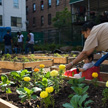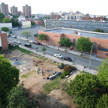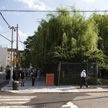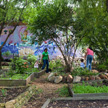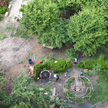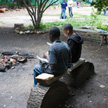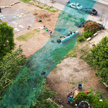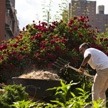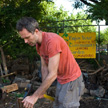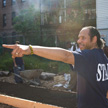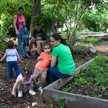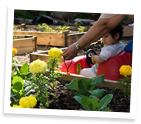Rewiring the City
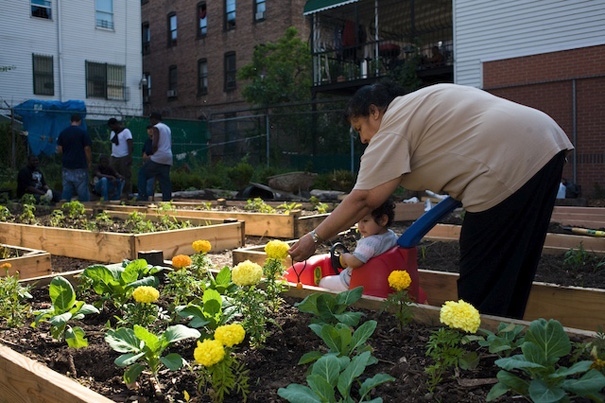
Stepping off the 6 train at Brook Avenue, I emerge into the heart of the South Bronx. To the south, the nine towers of the Mill Brook Houses rise 16 stories above the Deegan and Bruckner Expressways, a quintessential Robert Moses landscape, while to the north, Brook Avenue stretches away through a masonry canyon of five-story apartment blocks with grocery stores, salons, and fast food joints at street level.
The neighborhood is one of the most densely populated areas in the United States, and its reputation precedes it; this is what people are alluding to when they talk about the “inner city.” There’s nary a natural feature in sight.
Three blocks north, I’m standing at the edge of a muddy depression in what remains of an asphalt play lot while Aaron Petersohn conjures up a wholly different scene: a babbling brook alive with fish, frogs, and salamanders, shaded by native trees whose branches ring with birdsong. It is not a sweet reminiscence, though we are standing where a stream once ran, but a vision for the future. Mr. Petersohn is the project director for the Brook Restoration Project at Brook Park, an ambitious plan to “daylight” a portion of a long-buried waterway and create a verdant wetland in the heart of the South Bronx.
This project is no quixotic effort to stand athwart centuries of urban development yelling “stop!” Petersohn and his colleagues hope not only to recover a lost ecosystem but to put this system to work serving the needs of a twenty-first century urban community. Designed by the Gaia Institute of New York City, whose mission is to explore “how human activities and waste products can be treated to increase ecological productivity, biodiversity, environmental quality, and economic well being,” the wetland will act as a water-catchment system that takes millions of gallons of water a year out of New York City’s combined sewer system, reducing processing costs and preventing hazardous overflows. Humans have been harnessing efficient natural systems since before recorded history — using Nile flooding to fertilize farmland, planting symbiotic species together (e.g., the triad of corn, beans, and squash used by American Indians), and most recently investing in wind, solar, and tidal energy, including the turbines that sit in the East River — and Brook Park sits directly above an untapped natural water system, a former stream bed that still floods basements and warps pavement where it once burbled. As planned, the wetland project provides specific local solutions to citywide water management challenges, offering a model for open spaces around New York. It has the added benefit of creating a unique natural space adjacent to the community garden now on the site that will beautify the park and neighborhood, store water for gardening, and provide opportunities for hands-on environmental education.
“We’re rewiring the city,” Petersohn explains as we stand atop the former brook. “The city rewired nature, or tried to, but the reason we will be so successful is that we’re restoring the wetland that was here before. We’re going to set this up so that it runs itself.” Until the last decades of the nineteenth century, the Mill Brook ran from the hills around what is now Gates Place through the South Bronx, paralleling Brook Avenue before emptying into the Bronx Kill. Residents from the period recalled fishing and “bobbing for eels” (a technique that employs a bob, or weighted circle of bait, and is not at all like bobbing for apples) in the brook to WPA researchers in the 1930s, as well as watching the local fire department fill their tanks from the stream. However, as development boomed in the area, the Brook was first culverted and then filled altogether. City blocks were gridded atop the former channel, and the stream was consigned to memory.
But not entirely — a waterway cannot be wholly eliminated, and any attempt to do so brings repercussions. In the 100-plus years since it was buried, the Mill Brook has haunted the South Bronx, flooding basements along its former route — one development of town homes next to Brook Park was built without a basement level in the 1980s — and contributing to a high water table that muddies yards and parks. In Brook Park itself, willow trees flourish despite the absence of any visible water source, and a long puddle collects along the former riverbed after rain (hence the muddy depression). The ghost of the Mill Brook persists because a river is composed of both rainwater and groundwater, and while runoff can be redirected, groundwater is much harder to disperse.
Brook Park was created in 1979 from a series of vacant lots acquired by the city as a part of the South Bronx Neighborhood Open Space Development Project, and today the space houses a vibrant community garden, overseen by the Friends of Brook Park (FoBP). When their own research turned up evidence that the brook had flowed just west of their garden, which makes up roughly half of the vacant lots belonging to the park, FoBP began to seek ways to return this natural feature to the landscape. Partnering with the Gaia Institute, they have developed their current plan to bring a small portion of the Mill Brook back to life as a wetland “swale.”
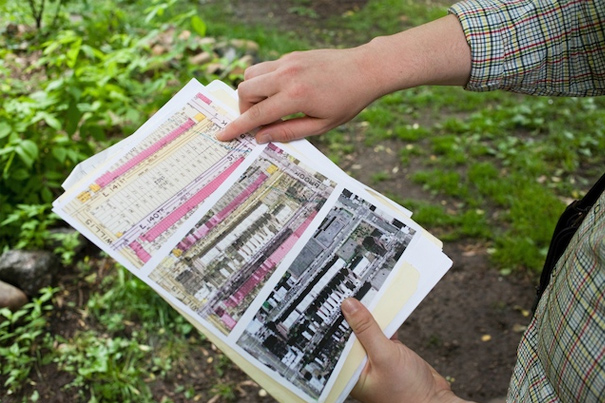
When Petersohn speaks of “rewiring,” he refers specifically to the natural water cycle that the swale will facilitate, which will effectively treat and process over 1.5 million gallons of rainwater per year without the help of the city’s combined sewer system.
New York City’s Department of Environmental Protection reports that 70% of sewers in the five boroughs are combined, meaning rainwater flows into the same mains as all other sewage and is treated as waste, instead of draining directly into waterways via separate storm drains. This man-made water cycle is both expensive and inefficient, subjecting billions of gallons of rainwater per year to full-scale sewage treatment, a costly process that environmental engineers say most runoff need not undergo. This added volume strains combined sewers to capacity, and in areas with high water tables — such as the South Bronx — a particularly big storm can flood the system, resulting in combined sewer overflows or CSOs. These overflows pour raw sewage into the city’s waterways — and occasionally into subway tunnels — creating environmental havoc and inviting hefty fines from the EPA. Without a massive capital influx to overhaul its sewers, the city must seek out ways to reduce the supply of rainwater in combined sewers that brings about CSOs.
The Gaia Institute’s design team engineered their proposed wetland in Brook Park to address this exact issue. The excavation itself will be filled partially with groundwater, but like the original brook, the swale will require rainwater as well. In partnership with local tenants and owners, FoBP plans to redirect and store rainwater from downspouts in underground and above-ground cisterns, which will be fed by a solar pump into the new body of water and will also be available for general garden use. The pump will monitor the water level to prevent flooding and keep the water in the swale flowing to prevent stagnation. “This park right here, it’s not contributing to the CSOs and to the sewer system. This is one way that this park is helping the city,” Petersohn says. “This isn’t low-impact design. This is beneficial-impact design.”
The completely restored wetland will be populated by indigenous species of flora and fauna, creating a rare urban space for environmental education. FoBP already partners with local schools to supplement their curriculum with what Petersohn calls “a visceral education,” and the daylighted brook will only serve to improve their programming. Native plantings will have to be counted and monitored for the first few years to prevent invasive species from upsetting the natural balance, a task that Petersohn and FoBP executive director Harry Bubbins see as an ideal lesson for neighborhood students. Animal life for observation will include dragonflies, frogs, salamanders, and fish, as well as migrating bird, which the design team predicts will make use of the wetland as a watering hole. A member of FoBP who introduced himself as Danny summed up the value of the park to local schoolchildren: “You take a kid to that park over there,” he said, gesturing across the street at a typical New York City play lot, “and he’s going to play basketball, handball, whatever you can do on that concrete. You bring a kid here, he’s going to learn.”
Last but not least, the swale will add a beautiful natural feature to an area that currently is only a third of the way to meeting New York City’s recommended 1.5 acres of green space per 1,000 residents. Local residents in the park expressed their approval, with nearly every one citing the need for more parkland in the South Bronx. The swale may even become something of an attraction for a green subset of New Yorkers. Quoting Gaia Institute executive director Paul Mankiewicz, Petersohn says “People will literally flock to see this wetland.”
It’s hard to picture standing next to the remnants of a mud puddle in the grey depths of February, but Gaia Institute has a record to stand on. Their first such project, at El Jardin Paradiso (EJP) on the Lower East Side, has blossomed into a local attraction housing two turtles and many more goldfish with over 20 native trees blooming on its banks. EJP’s Ariane Burgess reports that their swale — specifically engineered to combat lead contamination in the area — has become a favorite spot in the sprawling garden, one that looks “truly wild” in the height of summer. Roughly the size of a basketball court (the Brook Park swale would be similarly scaled), the wetland feels like a naturally-occurring pond, a found object that somehow survived the building of Manhattan unscathed. The effect borders on sanctifying — what holy writ earned these waters their reprieve? — and adds to the tangled, woodsy charm of the space, which looks more like something one might find in Central Park’s North Woods than stuck between Lower East Side tenements.
The brook restoration project remains in its planning stages as Friends of Brook Park await word on a grant submitted to the National Oceanic and Atmospheric Administration (NOAA). Petersohn is optimistic, and believes that the process has yielded an excellent project. “If somehow this funding doesn’t turn out,” he smiles, “we have a great plan to pursue other funding sources.” The Department of Parks and Recreation is behind the endeavor, and has submitted a letter of support, citing the plan’s “creative storm water management” and potential for “promoting education and awareness about the environment and sustainable development practices.” Non-governmental organizations from the Audubon Society to United Confederation of Taino People have expressed their backing as well.
Petersohn hopes that the project can be an example to local and citywide groups seeking to improve the functionality and beauty of the city’s open spaces. Of the Mill Brook, much of which will remain interred, Petersohn notes, “There are opportunities throughout the length of this Brook all through the Bronx. The great thing would be to find adjacent properties where you could do serious daylighting. Something like that would be ideal, and that’s something we can spark.” There is every reason to believe that the swale will turn out as well as the one at El Jardin Paradiso: FoBP have a thriving membership, established community partnerships, and a garden of flowers, fruit trees, and vegetables that looks pretty wild itself in the summertime. If it is completed, it is easy to see their swale serving as a model for more parkland and vacant lot conversions in the neighborhood. Bit by bit, the Mill Brook may rise again to serve the South Bronx, where locals once sought fish along its banks and extinguished fires with its waters.

